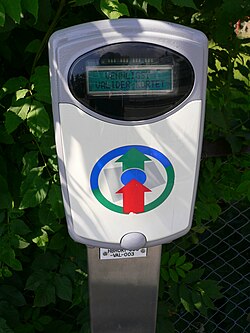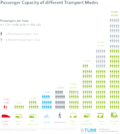Public transport

Public transport (public transportation in the United States) is the transport of passengers. Passengers don't need their own cars or other vehicles. Most public transport lets many people travel at the same time.
History
Ships have carried passengers since prehistoric times. That is the first kind of public transport. From the 17th century boats carried people along the canals.
Stagecoaches traveled a fixed route between coaching inns. There were buses in Paris in 1662. Around 1826 horsedrawn omnibuses operated in Nantes, France. They started in London in July 1829. Omnibuses were carts with seats for passengers to sit. The first passenger horse-drawn rail vehicle opened in 1806. It ran along the Swansea and Mumbles Railway. From 1825 steam railroads began carrying passengers between towns in England. Ferries (public boats) also became bigger and more numerous then.
Types of public transport
The main vehicles for public transport are buses, trolleybuses, trams and trains. Trams were first used in the late 1860s and used to be pulled by horses. Now trams are electric and run on a line of cable. Buses drive on the road, like cars do. Trolleybuses are like buses, but they use electricity from two wires above the road.[1] Trains run on a track and are very fast. Many places use trams and trains as a form of public transport.
Using public transport
Many people who do not have cars use buses, trolleybuses, trams to go places near their house, and they use trains to go places far away. Long-distance transport is usually by airline or train or other public transport. Local transport is more often private.
When using public transport people may need a ticket or card to be able to get on. A timetable tells them when they come, since they can only go when and where the transport is going.
Public transport is good for the environment. When many people use the same vehicle, fewer cars are on the road. Fewer cars make less pollution. Cost is low, because it is very cheap to catch public transport every day, which is why even people who own a car often use public transport.
+{{{1}}}−{{{2}}}
Modern public transport
Public transportation comes in many forms:
Road
- Share taxi including minibus and maxi-taxi
- Auto rickshaw
- Bus
- Bush taxi of West and Central Africa
- Trolleybus and electric bus
- Jitney or Songthaew
- Limousine
- Matatu, of East Africa
- Motor coach
- Paratransit
- Rickshaw
- Taxicab
- Transit bus
- Vanpool
- Vehicle for hire
- Velotaxi
- Combi of Peru
Rail
- Automated guideway transit (AGT), also called Peoplemover
- Cable car on rails, used in mountains.
- Rack railway (or rack and pinion railway)
- Elevated railroad, such as the Chicago 'L'
- Light rail a tram-like system with no significant sections of the route shared with cars or pedestrians, such as the San Diego Trolley or the St. Louis Metrolink
- Magnetic levitation train (Maglev)
- Metro (also known as 'subway' or 'underground')
- Monorail
- Railway, including commuter train and high-speed rail
- Tram (tramway or streetcar)
Water
- Ferry, including hydrofoil, catamaran and hovercraft
- Water taxi
Air
Sloped or vertical

- Aerial tramway or the more basic Aerial lift are vehicles suspended from aerial cables
- Chairlift
- Conveyor transport (term includes escalators and horizontal or slightly inclined moving sidewalk - "Travolator")
- Elevator or lift
- Funicular, used in mountains, tram-like vehicle on rails pulled by a cable up and down a very steep slope.
Some of these types are often not for use by the general public, e.g. elevators in offices and apartment buildings, buses for personnel or school children, etc.
Emerging technologies
Stations
Stations are an important aspect of any public transportation system. Specific types include:
- Airport, Heliport
- Airport terminal
- Bus station
- Bus stop (including bus station, bus depot)
- Metro station
- Park and ride
- Ship terminal, ferry slip, pier or wharf
- Taxi stand
- Railway station
- Tram stop
In addition one can get on or off a taxi at any road where stopping is allowed. Some fixed-route buses allow getting on and off at suitable unmarked locations along that route, typically called a hail-and-ride section.
Financing
Money is needed to build and operate a public transit system. The money comes from ticket revenue, government subsidies and advertisements. If ticket prices are too high, people will not use it. So, most systems charge passengers less than the full cost of building and operating the system. The percentage of total revenue that passengers pay is known as the farebox recovery ratio. Sometimes income comes from land development and rental from stores and vendors, and parking fees. Some subway systems get money from telecommunication companies by leasing tunnels and rights-of-way to carry fiber optic communication lines.
Fare and ticketing
For many public transport systems, passengers must buy a ticket. Tickets may either be bought before the ride, at the time of the ride, or both. Tickets can be paper ticket, metal or plastic tokens, or an electronic card (smart card, contactless smart card). Sometimes, a ticket has to be validated (marking the time of the ticket's use). A paper ticket is stamped when it is validated. An electronic ticket is checked in.
Tickets may be valid for a single (or return) trip, or valid within a certain area for a period of time. The fare (price of the ticket) is based on the travel class, either based on the traveled distance, or on a zone pricing.
The tickets may have to be shown or checked automatically at the station platform or when going onto the system, or during the ride by a conductor. Operators may choose to control all passengers, allowing sale of the ticket at the time of ride. Alternatively, a proof-of-payment system allows passengers to enter the vehicles without showing the ticket. Riders may or may not be controlled by a ticket controller. If the rider does not show proof of payment, the operator may fine the rider.
Multi-use tickets allow a passenger to travel more than once. These include "return tickets" where the passenger pay for two trips at one time. It also includes period cards allowing travel within a certain area (for instance month cards), or during a given number of days that can be chosen within a longer period of time (for instance eight days within a month). Some transit systems sell tickets (passes) aimed at tourists that allow free or discounted entry at many tourist attractions, typically include zero-fare public transport within a city. Period tickets may be for a particular journey (in both directions), or for a whole network.
A free travel pass allows free and unlimited travel within a system. Free passes are sometimes granted to particular social sectors, for example students, old people, children, employees (job ticket) and the physical or mentally disabled. In the United States, an employer can pay for a portion of a travel pass without that payment being taxed. So, transit systems allow employers to pay the system directly and to distribute the passes to employees.[2]
Free systems
Free or Zero-fare public transport services are funded in full by other ways than collecting a fare from passengers. Zero-fare services may be funded by national, regional or local government through taxation or by commercial sponsorship by businesses. They usually use relatively small vehicles such as buses and trams. Several mid-size European cities and many smaller towns around the world have converted their entire bus networks to zero-fare. Local zero-fare shuttles or inner-city loops are far more common than city-wide systems.
On 29 February 2020, Luxembourg became the first country in the world to make all public transport in the country (buses, trams, and trains) free to use.[3][4][5][6][7]
Cultural importance
Tourist attraction
Some rail-based public transport are also tourist attractions and/or well known landmarks in their own right. These include San Francisco's famous cable cars, the Molli steam powered train in Bad Doberan, the kusttram along the whole Flemish coast, the Schwebebahn Wuppertal, the Seattle Monorail, and the Christchurch Tram
Advocacy organizations
- American Public Transportation Association
- Community Transportation Association of America [1]
- International Association of Public Transport [2] Archived 2011-02-03 at the Wayback Machine
- Light Rail Transit Association (UK)
- National Corridors Initiative [3] Archived 2008-03-27 at the Wayback Machine
- Public Transport Users Association – a lobby group for Victoria (Australia)
- Taxicab, Limousine & Paratransit Association (TPLA) [4] Archived 2010-03-06 at the Wayback Machine
- Transport 2000 (UK)
Public Transport Media
An omnibus design from 1828, Paris
A Newton and Boston Street Railway trolley car in Newton, Massachusetts
Vienna West railway station
Cycle Superhighway CS6 is part of London's Cycle Network infrastructure.
eTricks C01, electric bicycle made in France
Bus top next to a tramway station on the Sydney light rail network.
A contactless validator in Brno
References
- ↑ Joyce, J.; King, J. S.; and Newman, A. G. (1986). British Trolleybus Systems, pp. 9, 12. London: Ian Allan Publishing. ISBN 0-7110-1647-X.
- ↑ "Qualified Transportation Fringe Benefits under ARRA". Internal Revenue Service. October 4, 2011. Archived from the original on 2011-10-16. Retrieved 2011-10-19.
- ↑ "Luxembourg makes public transport free". Deutsche Welle (DW). 29 February 2020. https://www.dw.com/en/luxembourg-makes-public-transport-free/a-52582998. Retrieved 10 April 2020.
- ↑ Kirby, Paul (29 February 2020). "Free transport in Luxembourg, but what's the cost?". BBC News. https://www.bbc.co.uk/news/world-europe-51657085. Retrieved 10 April 2020.
- ↑ Abnett, Kate (29 February 2020). "Luxembourg becomes first country to make public transport free". Reuters (Luxembourg). https://www.reuters.com/article/us-luxembourg-politics-transportation-idUSKBN20N0RX. Retrieved 10 April 2020.
- ↑ Calder, Simon (29 February 2020). "'Like the first step on the moon': Luxembourg makes history as first country with free public transport". The Independent. https://www.independent.co.uk/travel/news-and-advice/luxembourg-free-travel-train-bus-tram-public-transport-rail-fares-ticket-a9366226.html. Retrieved 10 April 2020.
- ↑ "Luxembourg becomes first country with free public transport". France 24 (Luxembourg). 29 February 2020. https://www.france24.com/en/20200229-luxembourg-becomes-first-country-with-free-public-transport. Retrieved 10 April 2020.
More references
- Australia: Trinity College, Western Australia Archived 2008-04-15 at the Wayback Machine
- USA Transport Research Board TRIS Database Archived 2008-07-20 at the Wayback Machine
Other websites
| Wikimedia Commons has media related to Lua error in Module:Commons_link at line 62: attempt to index field 'wikibase' (a nil value).. |
- NAUTF | North American Urban Transit Forum Archived 2018-02-01 at the Wayback Machine
- APTA: American Public Transportation Association
- Public Transportation: Wherever Life Takes You
- IMB International Maglev Board
- Metro systems' graphics indexed by city
- The biggest database and photogallery of public transport
- National Transit Institute
- Transport Briefing Archived 2004-12-04 at the Wayback Machine
- Public transport in Russia
- Public transport guide (Europe)


















